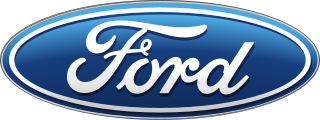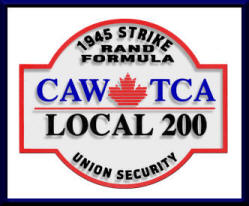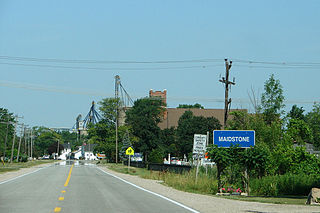
The Hudson Motor Car Company made Hudson and other brand automobiles in Detroit, Michigan, U.S., from 1909 to 1954. In 1954, Hudson merged with Nash-Kelvinator to form American Motors Corporation (AMC). The Hudson name was continued through the 1957 model year, after which it was discontinued.

The Ford Modular engine is Ford Motor Company's overhead camshaft (OHC) V8 and V10 gasoline-powered small block engine family. The Modular engine got its name from its design and sharing of certain parts among the engine family, starting with the 4.6L in 1990 for the 1991 model year. The name was also derived from a manufacturing plant protocol, "Modular", where the plant and its tooling could be changed in a few hours to manufacture different versions of the engine family. The Modular engines are used in various Ford, Lincoln, and Mercury vehicles. Modular engines used in Ford trucks were marketed under the Triton name from 1997–2010 while the InTech name was used for a time at Lincoln for vehicles equipped with DOHC versions of the engines. The engines were first produced in Romeo, Michigan then additional capacity was added in Windsor, Ontario.

The Highland Park Ford Plant is a former Ford Motor Company factory located at 91 Manchester Avenue in Highland Park, Michigan. It was the second American production facility for the Model T automobile and the first factory in history to assemble cars on a moving assembly line. It became a National Historic Landmark in 1978.

The Ford Essex V6 engine was a 90° V6 engine family built by Ford Motor Company at the Essex Engine Plant in Windsor, Ontario, Canada. Unlike the British Essex V6, the Canadian Essex used a 90° Vee configuration, in addition to having different displacements and valvetrains. This engine was succeeded by the Ford Duratec 35, and the last one produced was found in 2008 F-150.
Harrow is a community located in the town of Essex, Essex County, Ontario, Canada.

Ford of Britain is a British wholly owned subsidiary of Blue Oval Holdings, itself a subsidiary of Ford International Capital LLC, which is a subsidiary of Ford Motor Company. Its business started in 1909 and has its registered office in Brentwood, Essex. It adopted the name of Ford of Britain in 1960.

The Ford Wixom Assembly Plant was a Ford Motor Company automobile assembly plant in Wixom, Michigan, United States.
Windsor Casting Plant was an iron foundry owned by Ford Motor Company in Windsor, Ontario, Canada. The plant opened November 9, 1934 and was located next to the Windsor Engine Plant in downtown Windsor. It was known to area residents as "the foundry". Internally, it was called WCP.
Ford Motor Company's restructuring plan, made public in 2006, was known as The Way Forward. Ford was attempting to reduce fixed capital costs while maintaining a special focus on cars and car-based crossover vehicles. Over time, it hoped to make more of its product line profitable instead of relying on a limited portion of the products for profit. Making good profits across the product line required that the company reduce the costs of development and production, while introducing new products that connect with consumers.
Automotive Components Holdings, LLC is a Ford Motor Company-managed temporary business formed by the 2005 transfer of 17 automotive components factories and six research, testing and other facilities from Visteon Corporation to Ford. The creation of ACH was intended to ensure that Ford continued to receive a flow of parts from the facilities, whilst enabling them to be prepared for sale or other disposition.

Unifor Local 200 is a local union of the general trade union Unifor. It represents auto industry workers in Windsor, Ontario at three Ford Motor Company of Canada engine plants and one Nemak aluminum casting plant.

Maidstone, Ontario, is a small hamlet on Essex County Road 34 in the town of Tecumseh, Ontario, Canada. The town has a post office, a school, baseball diamonds, a park, a conservation area, a cemetery, a church, restaurant, community center and a grain elevator.
The Windsor Salt Mine currently operates two locations in Windsor, Ontario, Canada. The first is the Ojibway Mine at 200 Morton Drive in Windsor, established in 1955, and is owned by The Canadian Salt Company, Limited. The facility has 250 employees, earns roughly $75–99 million a year, producing road and mining salt. The second location is the Windsor Facility of the Canadian Salt Company, located at 30 Prospect Ave. in Windsor. This facility employs 110 and estimates their sales at $25–50 million a year. It was established much earlier than the first, in 1893. Their main products are salt used for human consumption, water softening and agriculture. In 2008, Canadian Salt mined approximately 9,500 kilotonnes from the Windsor mine, 85% of which went to deicing highways, and the remainder for manufacturing caustic soda and chlorine, producing pulp and paper, and water treatment.

The fourth generation Ford Mustang was an automobile produced by the American manufacturer Ford for the 1994 through 2004 model years. For 1994 the Ford Mustang underwent its first major redesign in fifteen years, being introduced in November 1993 and launching on December 9, 1993. The design, code named "SN-95" by Ford, was based on an updated version of the Fox platform, the final Ford vehicle underpinned with this platform. It featured styling by Bud Magaldi that incorporated some stylistic elements from the classic Mustangs. A convertible returned, but the previous notchback and hatchback bodystyles were discontinued in favor of a single fastback coupe bodystyle.
Windsor Raceway was a standardbred harness racing track located in Windsor, Ontario. The track was 5/8 of a mile in length. The facility closed August 31, 2012.

A substantial car industry was created in Australia in the 20th century through the opening of Australian plants by international manufacturers. The first major carmaker was Ford Australia and the first Australian-designed mass production car was manufactured by Holden in 1948. Australian manufacture of cars rose to a maximum of almost half a million in the 1970s and still exceeded 400,000 in 2004. Australia was best known for the design and production of 'large' sized passenger vehicles. By 2009 total production had fallen to around 175,000 and the Australian market was dominated by cars imported from Asia and Europe.

Henry Ford's Village Industries were small factories located in rural areas of Michigan. Ford developed his Village Industries in part to provide farm workers a stable source of income during the winter months.
Essex Engine Plant is a Ford factory located in Windsor, Ontario, Canada. It currently produces Ford's 5.0L V8 engine. The plant was built in 1981 to produce Ford's Essex V6 engine.

The Ford Mack Avenue Plant, a rented wagon manufacturing shop in Detroit, Michigan, was the first facility used by the Ford Motor Company to assemble automobiles. Henry Ford began to occupy it in April 1903 in preparation for the company's incorporation, which occurred on June 16, 1903. Production of the original Ford Model A began that same month after the incorporation. Soon after, the building was expanded and a second story was added to increase production. The Model A was followed by the Model AC, which was a Model A with the larger Ford Model C engine. Most of the major car components were manufactured by outside companies, including the "running gear", which was supplied by the Dodge Brothers Company. A total of 1,708 cars were assembled at the Mack Avenue Plant. The company occupied the building until October 1904, when its manufacturing operations were moved to the Ford Piquette Avenue Plant in Detroit, where the Ford Model T would later be built.















